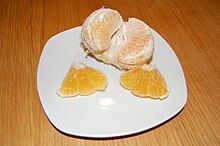Ugli
The ugli is a citrus fruit that is said to have originated as a product of a hybridization of mandarin ( Citrus reticulata ) and grapefruit ( Citrus × aurantium ) or pomelo ( Citrus maxima ). Crosses of mandarin and grapefruit are known as tangelo . It was found in Jamaica around 1917 and marketed commercially from the 1930s. As a trademark , the fruit is available as UGLI® from Cabel Hall Citrus Ltd. registered. The name is supposedly derived from its rough and greenish-yellow skin, which aroused associations with the English word ugly for ugly.
The tree has an upright habit and is reminiscent of a mandarin tree.
The fruit has a diameter of 10 to 15 centimeters. The shape is rounded and somewhat flattened. The color of the ripe fruit is yellow, with a hint of orange, greenish at the ends. The skin is rough and leathery, it can be peeled easily. The white mesocarp (albedo) is quite thick. The fruit is divided into about twelve segments, which are filled with orange, juicy pulp. The taste is aromatic, sweet, with little acidity or a taste typical of grapefruit. The central axis of the fruit is hollow. Occasional seeds contain only one embryo.
It is available as a seasonal product from December to April, but is rarely on the market in German-speaking countries.
See also
literature
- Julia F. Morton: Tangelo . In: Julia F. Morton (Ed.): Fruits of warm climates . Miami (FL) 1987, p. 158-160 ( online [accessed April 30, 2008]).
- Robert Willard Hodgson: Horticultural Varieties of Citrus . In: Walter Reuther, Herbert John Webber, Leon Dexter Batchelor (eds.): The Citrus Industry . tape 1 . University of California - Division of Agricultural Sciences, 1967, Chapter 4 ( online [accessed April 30, 2008]).

